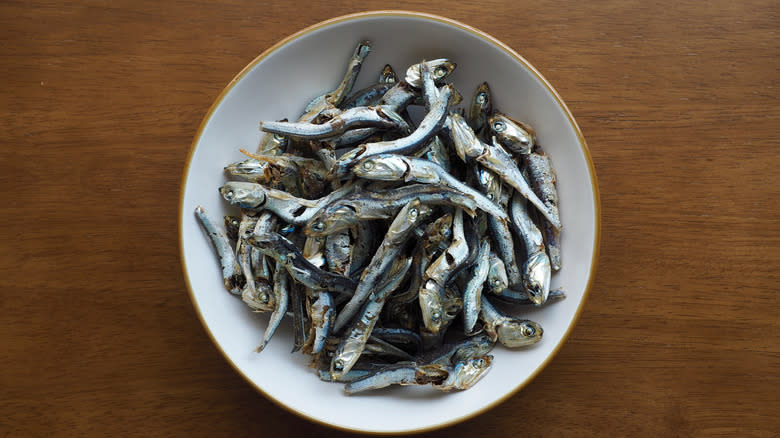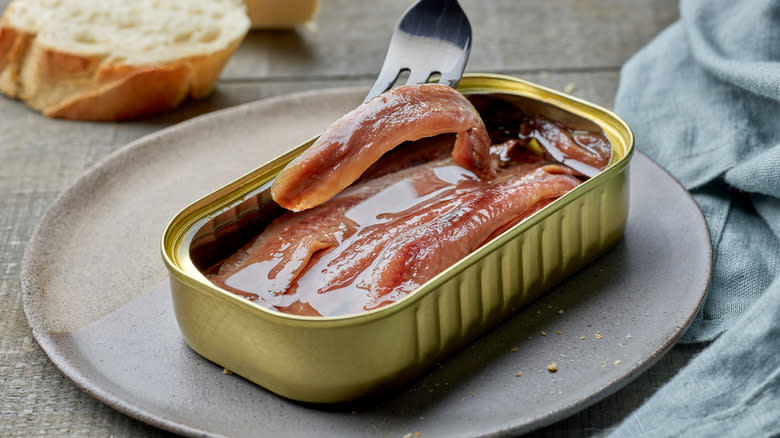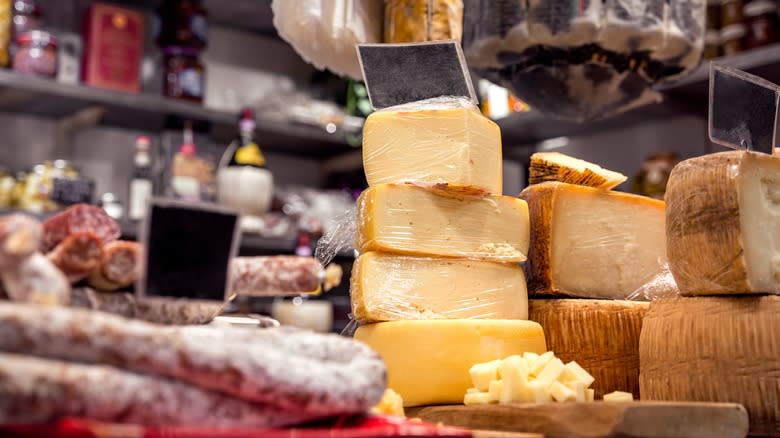Anchovy Paste Is The Flavor-Enhancing Ingredient You're Probably Sleeping On

"Teenage Mutant Ninja Turtles" lied to us all: anchovies are delicious on pizza, or in any other context. Anyone who has ever eaten fresh anchovies can tell you they're absolutely wonderful as the star of restaurant appetizers like Spanish fried anchovies. But the packaged ones are still great -- as long as you know how to use anchovies. If you're dealing with tinned anchovies, a lot of people make the mistake of just trying to eat a whole one still dripping with oil, assuming that's the only way you can do it.
Make no mistake, anchovy flavor is potent, and eating it straight is a challenge even for people who love it. This goes double for the other anchovy-based ingredient that's the secret to so many great recipes, particularly Italian ones: anchovy paste. If you're dealing with a seafood pasta or noodle dish, there's really no other ingredient that can jazz your ocean flavors up like anchovy paste.
Read more: The Ultimate Ranking Of Canned Salmon Brands
What Is Anchovy Paste?

Since anchovies have been used as an edible food source for thousands of years, it's not surprising the history of anchovy paste dates back nearly as far. The oldest historical references are to something called allec, the paste left over from the preparation of fish sauces (made up of oily fish, including anchovies) during the Greek and Roman Empires. It's uncertain when it developed into modern anchovy paste from there, but the version we're talking about was eventually established in Italy.
Really, though, turning anchovies into some kind of paste isn't unique to one region -- which isn't surprising, since anchovies are eaten in hundreds of cultures around the world. There are products similar to the Italian version of anchovy paste in countries like Vietnam (where it's called "mam nem") and the Philippines (where it's "bagoong bala yan"), although the texture of those versions is somewhat different. They have a lot more liquid and are thus more of a dipping sauce in their own right.
How Is Anchovy Paste Made?

The process of making anchovy paste is simpler than you might think. Simply put, anchovy paste is a mashed mixture of anchovies (typically fully cured brown anchovies, as uncured white anchovies are more commonly eaten whole), vinegar or oil, spices, and water. It's sometimes made from leftover anchovies, as you don't have to worry if the texture is a little weird. As such, you can theoretically make it yourself at home.
Which spices and oil/vinegar you use (or which ones the company you bought it from used) will give it a different flavor profile, though. Some brands will go for a mellower flavor with olive oil and/or sunflower oil, while other recipes are going to go for a sharper bite using vinegar. For spices, it can involve any number of them, including ginger, black pepper, or even cinnamon. Some recipes might even call for Dijon mustard. The one ingredient that's absolutely necessary is salt. You're not going to get that classic anchovy flavor without it.
What Does Anchovy Paste Taste Like?

If you're wondering what anchovy paste tastes like when eaten by itself, the answer is not all that surprising considering what the whole filets taste like: salt. So much salt. Just the entire Pacific Ocean's worth of salt. This is the reason that, while you could eat it as a condiment (very similar products certainly are in places like the UK, Vietnam, and the Philippines), it may not be its ideal use-case for most Americans. If you're going to eat anchovy paste straight up on something, you probably want to do so in small quantities rather than large ones so as not to overwhelm whatever you're putting it on.
Even there, it's hard for anchovy paste not to take over -- and the texture isn't something you want completely by itself -- which is why the important thing is to make sure it's balanced. In small quantities, it's particularly good on things like egg dishes on toast, or anything else that provides a flavor and textural counterpoint. It also works very well in spreads like tapenades, since olive and anchovy flavors marry well together.
How To Cook With Anchovy Paste

There are actually a whole bunch of things you can do with anchovy paste. Its primary use in Italian cooking is in sauces, particularly seafood-based pasta, where it tends to supercharge ocean flavors. But it has a lot of other applications, too. It can be used in salad dressings, where it's often the source of that unique flavor present in Caesar dressing (although the original creator of the Caesar salad stubbornly disagreed). It's great as part of a marinade for meat, particularly if you're going to grill something like steak. It also works well with in dishes like empanadas and salsa, where the saltiness of the anchovy paste tends to be naturally balanced by the spice-forward flavors common to Latin American cuisines.
Ultimately, the best way to use anchovy paste, and anchovies in general, is very similar to how you use salt -- as an enhancer to other flavors. It marries well with a lot of different things as long as you don't overuse it, and you can use it pretty much anywhere you want to salt a dish while giving it a little bit of an umami boost at the same time. Its greatest strength is its versatility. Again, though: don't use too much, because a little bit goes a surprisingly long way.
Where To Buy Anchovy Paste

This part can be a little trickier. Most grocery stores will have anchovy paste, and you'll want to look in the same aisle as the canned fish. Unsurprisingly, it'll probably be right next to the anchovies. But most major chains will typically only have one brand, and a lot of times it'll be brands that are just okay. For that reason, the best place to find it is going to be any local Italian specialty store. Fortunately, anchovy paste does travel well (it needs to be refrigerated after opening, but not before), so you can generally order it online and it'll turn out okay as long as it was properly stored during transport. One very good brand to look for is Scalia Benedetto, a Sicilian variety known as some of the best commercially available anchovy paste in the world -- in part because it's made with extra virgin olive oil.
Wherever you get it from, though, you should be using anchovy paste to boost your sauces, your dips, pretty much whatever you want considering how versatile the stuff is. You'll be amazed at how much of a difference it can make.
Read the original article on Daily Meal.

